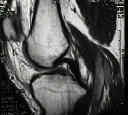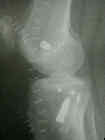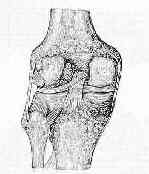
- bone patella bone allograft or achilles tendon allograft;
- if achilles tendon is used, the free end is secured w/ a locked whip stitch (Krackow stitch);
- in the report by Fanelli et al. 1996, there was no disadvantage to the use of Achilles allograft tissue;
- tendinous portion of graft should be at least 4.5 cm;
- pre-tenioning of the graft w/ more than 43 N is essential before it is anchored in place;
- references:
- Comparison of the Split Stacked Versus the Split Achilles Allograft for Dual Femoral Tunnel Posterior Cruciate Ligament Reconstruction.

- anterolateral portal:
- anteromedial portal
- posteromedial portal:
- needs to be positioned to allow soft tissue and PCL to be cleared off the posterior tibial wall (using currettes and graspers);
- currettes can also be used to protect injury to N/V structures during insertion of the tibial tunnel guide wire;
- posteromedial portal is also used to facilitate passage of graft material around the sharp turn of the tibial tunnel;
- plastic cannula may facilitate passage of instruments thru this portal;
- pass a 70 deg scope thru the notch to improve visualization;
- central portal:
- if a bone patella bone harvest is to be performed, do not make this portal until after the tendon has been harvested;
- make a small verticle incision just beneath the center of the patellar tendon;
- allows better view of tibial tunnel placement;
- Graft Positioning:
- Femoral Tunnel:
- Tibial Tunnel:

- references:
- Pearls and Pitfalls of Single-bundle Transtibial Posterior Cruciate Ligament Reconstruction
- Clinical comparison of conventional and remnant-preserving transtibial single-bundle posterior cruciate ligament reconstruction combined with posterolateral corner reconstruction.
- Graft Passage:
- various devices are availabe to facilitate graft passage (curved wire passers and tunnel smoothers);
- femoral bone plug should be no longer than 20 mm so that there will be less difficulty in turning corner from tibial tunnel exit site to femoral tunnel entry site;
- the designated tibial bone plug may be left longer than 25 mm, which will make it easier to engage plug w/ an interferance screw;
- some authors prefer passing Achilles tendon allograft from the femoral to the tibia tunnel;
- arthroscopic probe can be used to re-direct the bone plug sutures in the optimal direction for graft passage;
- Soft Tissue Fixation:
- tibial side is secured first;
- anterolateral bundle:
- anterior drawer stress is applied (40 lbs) to the tibia (w/ knee in mid-flexion vs 90 deg flexion) prior to fixation of the remaining side;
- posteromedial bundle:
- anterior drawer with the knee in 0 to 30 deg of flexion; (fixation in 0 deg extension will help prevent hyperextension);
- references:
- Posterior cruciate ligament revision reconstruction, part 1: causes of surgical failure in 52 consecutive operations.
- Posterior cruciate ligament graft fixation angles, part 2: biomechanical evaluation for anatomic double-bundle reconstruction.
- Postoperative Care:
- most often the PCL is immobilized in extension for two weeks;
- activities that involve loading of knee while it is flexed beyond 90° (such as kneeling, squatting, or climbing high stairs) are avoided
in early postop period;
- consider avoiding active knee flexion for 6-8 weeks inorder to avoid posterior subluxation from hamstring tension;
- in some cases, manipulation under anesthesia between 6 and 8 weeks after surgery is necessary to restore full flexion;
- references:
- The Effect of Femoral Tunnel Position on Graft Forces During Inlay Posterior Cruciate Ligament Reconstruction.
- Rehabilitation after posterior cruciate ligament reconstruction: a review of the literature and theoretical support
- Complications:
Posterior Cruciate Ligament Revision Reconstruction, Part 1. Causes of Surgical Failure in 52 Consecutive Operations.
A Biomechanical Study of Replacement of the Posterior Cruciate Ligament with a Graft. Part II: Forces in the Graft Compared with Forces in Intact Liagment.
Isolated posterior cruciate ligament injuries in athletes.
Arthroscopically assisted combined anterior and posterior cruciate ligament reconstruction.


